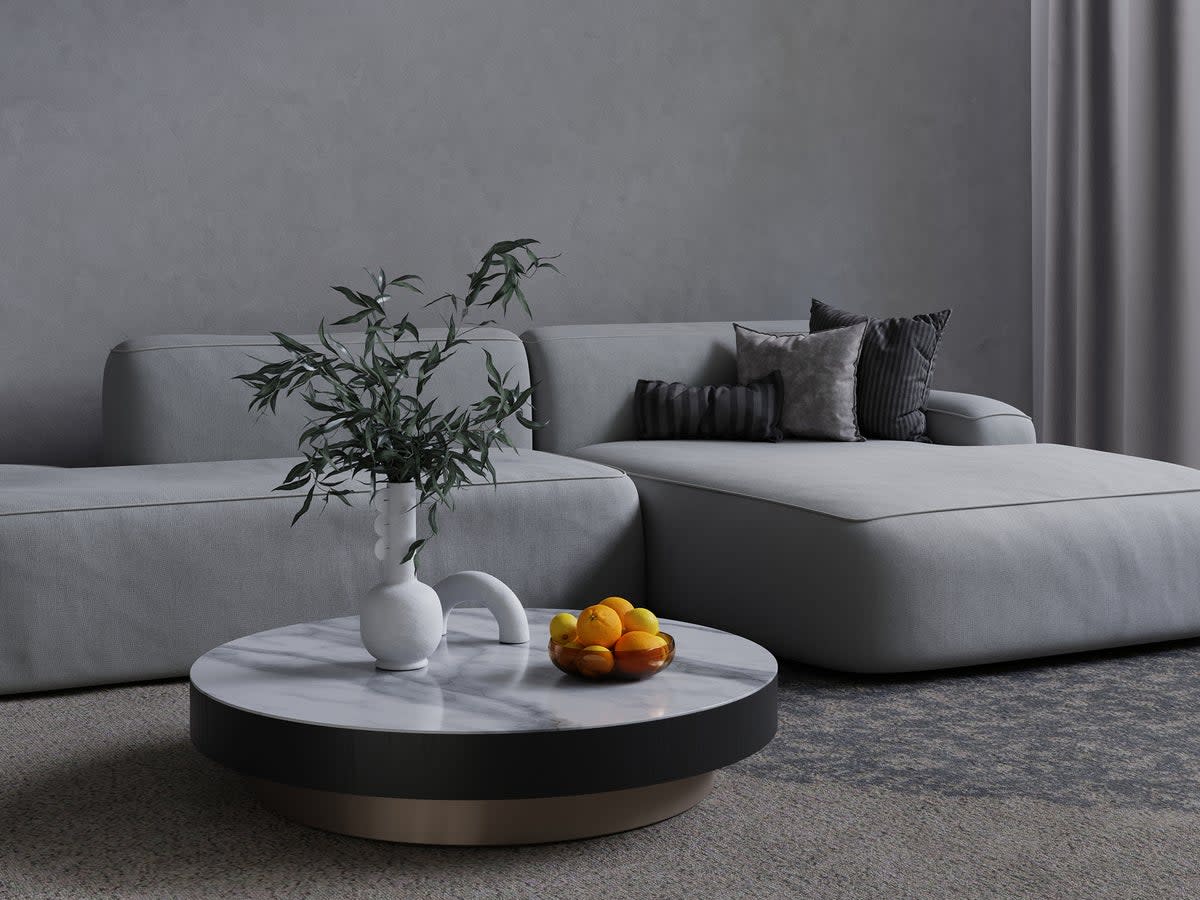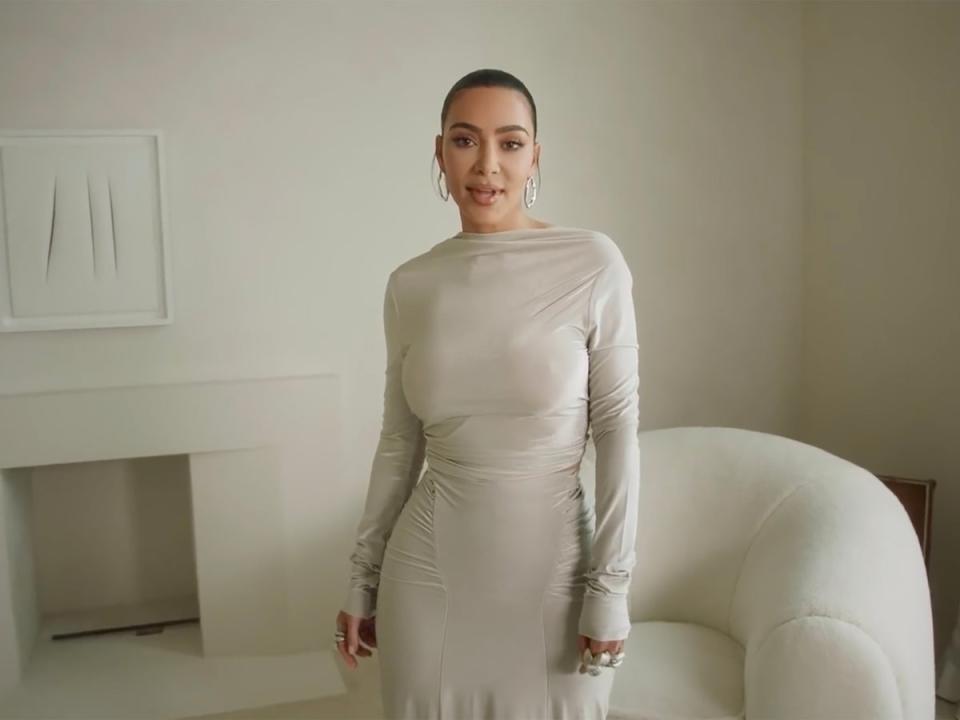Fade to greige: When did Britain’s homes become so sad and colourless?

- Oops!Something went wrong.Please try again later.
You’ve seen the pictures: a “before” photo of Victorian tiling around a fireplace. Or a wooden mantelpiece. Or a pastel pink sink with matching soap dishes inset into a colourful tiled wall. Then you flick to the “after” and find that you’ve suddenly been plunged into a greyscale world, like Dorothy in The Wizard of Oz but in reverse. Check out this amazing transformation, the posts shriek! Every single unique feature has been pulverised and scrapped, so we can make our homeownership design dream come true. And that dream – the one we have scrimped and saved and strived for, ISA over fist – is to live in the grey zone.
Grey walls, grey floors, grey corner sofa. Grey crushed velvet headboard. Grey fences surrounding gardens purged of life in favour of grey paving slabs and pebbles. Grey rattan outdoor furniture and a fire pit. So flammable; so Instagrammable. Dubbed the “grey plague”, this so-neutral-its-deathly palette of “greige” has been the look of our times for what feels like aeons now. On practically every street and at every corner of the internet, you’ll find them – these humourless housing reboots, where all character has been destroyed in favour of life in a desaturated Lego block. You look at each new iteration, a near identikit copy of the last, and it’s hard not to tip into paranoia. Is there a plot to drain colour from the world? Why are so many people falling over themselves to fit a grey filter to reality, covering everything in a dull wash that resembles nothing more than the distorting lens of depression? As one Redditor put it, “It’s just soul destroying to come in from a grey, gringey British cold winter night, and oh look! Your entire house looks like outside.” Why does everything look the same, and also awful?
From the late 2010s onwards, we’ve been living in fifty shades of grey, and not in a sexy way. Charcoal, concrete, slate. Or, if you’re after something more evocative, why not “Elephant’s Breath”, which has ranked among Farrow & Ball’s top 10 shades for the past 12 years, and been named a “paint colour of the decade” in the UK. As brown was to the Seventies, and magnolia was to the Eighties and Nineties, grey is the defining colour of now. The blame for this can, in some senses, be laid at the feet of IKEA. In the late 1990s, as the Swedish company started to break into US and UK markets with its do-it-yourself, simple and hard-wearing homewares, Scandi style took off as a trend. Neutral and natural was best. Then, an injection of Aughts industrialism and artisanal aspiration, and coffee shops, cafes and bars started looking a bit like factories: all hard edges, exposed light fittings and, of course, slabs of metal, concrete and slate. At home, this was softened, but the essential idea was the same. Minimalism meant good taste; grey meant contemporary, fashionable, up to date.
Truthfully, however, neutral palettes have been imagined as the sophisticated choice for centuries. Johann Wolfgang von Goethe’s Theory of Colours, published in 1810, maintained that bright colours were suited to children and animals, not adults. Bold colour has long been perceived to be feminine, or childish, or simply garish. The muted and minimal, on the other hand, has often been associated with refinement. More than anything though, a neutral palette of greys is bland. It is sensible, functional and multipurpose. Boring, sure, but also thought to be soothing – a stress-free backdrop. So, is this the real reason everything has gone grey? Because we’re living in an age of screens and instability, and we’re all looking to be soothed? It is, after all, not just people’s homes – turn on the TV or go to the cinema and you’ll see most modern media has been colour graded to a grey “sludge”. The tech we use daily is also no longer bright and bulbous, but gunmetal, silver and chrome. Is this a mark of refinement and adulthood, or is it a sign that people are overstimulated and overwhelmed? From the bubblegum millennium onwards, what we surround ourselves with has got progressively cooler, as global politics and the climate have been heating up.
“Everything in the outside world is so chaotic. I like to come into a place and immediately feel the calmness,” Kim Kardashian, queen of minimalism, said in early 2020. While many have instead described Kardashian’s sparse, monastery-like mansion as “naff and soulless”, this sentiment seems to have taken hold more firmly during the pandemic – when our homes were transformed into literal shelters against the uncertainty and Covid threat outside. People’s homes were forced to become multi-purpose bunkers, so it made sense that they’d simultaneously become more important, and more drab, lifeless and unexciting. If you’re sitting inside staring at the same four walls every day, perhaps for your own sanity you’d prefer them to be a soothing shade of sludge. And so, just as the pandemic prompted a new era of homeworking, it also inspired a boom in DIY home renovations – ones inspired by photos of similar projects shared on social media, and ones that prioritised creating a pacifying, tranquilising effect.
Yet, perpetual greyscale is, in fact, already old news. Like magnolia before it, greige has gone the way of all home interior fads – from aspirational trend and mark of refined, urban taste to the ubiquitous choice of landlords everywhere, looking to boost their monthly earnings with a lick of Elephant’s Breath over visible spores of mould. Like reclaimed wood, and industrial fittings, grey is now a sure-fire symbol of what has been termed “International Airbnb Style”. Ubiquitous, easy, and cheap. And… dispiriting during a housing crisis.
More than its bland dullness, this is the truly worst part of the new wave of home renovation content. The part that makes me want to shove cocktail sticks into my eyes every time I see another influencer rip out a beautifully tiled fireplace. Because housing has never been at such a premium – so expensive to buy, and so inaccessible to younger generations. Research undertaken for The Guardian in December revealed that asking rents on new listings were up by almost a third since 2019, with some people facing increases of up to 60 per cent. Prices in 48 council areas are now classed by the Office for National Statistics as unaffordable when compared with average wages.

In the rental sector, people are often forced to live in drab blandness with no hope of ever being able to rip up an ugly carpet or paint a wall in any shade. Yearning to splash some personality on the spaces in which we live, without reprisal from landlords and letting agents, renters are forced to watch people who can afford houses of their own destroying any last vestiges of character, in favour of spiritless uniformity. But, perhaps this is also the real reason dedicated house renovation Instagram accounts have surged in popularity recently. Just like looking at airbrushed and edited photos of “makeup free” models, following house porn accounts is, for many, looking at an impossibly unattainable dream.
“After exchanging contracts and picking up the keys,” Alice Vincent recently wrote in The Financial Times, “people are now setting up dedicated Instagram accounts for their homes.” Getting your digital dopamine hit via a cutesy doggy ’gram is so 2016 – now it’s all about monetising every carpet pull and paint job through sweet social media sponsorship deals. And I don’t think it’s an exaggeration to say that all this “aspirational” home renovation content is making people insane. There is an ignorance and icky power play often on display by content creators who proudly declare their intention to “fix-up” and flip properties, and get paid by brands for the pleasure.
“Anyone else make fancy washed coffee for their builders,” one home renovation influencer asked on their Instagram Story recently. “I swear it is the secret to keep them coming back every day.” Because, of course, they might be the builders, but you are the artisan – the one with the refined taste, that you so graciously bestow upon the common man, as he transforms your three-bed semi into an almost exact copy of every other house on Instagram. Neutral, bland, and most of all grey. Ready to be transformed into a buy-to-let at the earliest opportunity, where the tenants will sit and dream of one day being able to step into a world of Technicolor.

